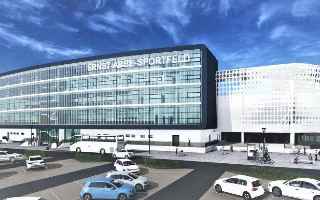Ernst-Abbe-Sportfeld – until 2020
| Capacity | 10 445 |
|---|---|
| Country | Germany |
| City | Jena |
| Clubs | Fußballclub Carl Zeiss Jena e. V. |
| Retire year | 2020 |
| Floodlights | 850 lux |
| Other names | Jenaer Stadion |
| Inauguration | 24/08/1924 |
| Construction | 1922–1924 |
| Renovations | 1974, 1978, 1991, 1997–1999, 2006, 2007, 2010, 2018 |
| Record audience | 27,500 (28/03/1962, SC Motor Jena – Atlético Madrid 0–1) |
| Design | Heinrich Voßler (1924), Werner Schröder (new main stand, 1997) |
| Address | Oberaue 3, 07745 Jena |
Advertisement
Ernst-Abbe-Sportfeld – historical stadium description
What was the former Ernst-Abbe-Sportfeld like in a nutshell?
The Jena stadium opened in 1924, and 15 years later it was named Ernst Abbe. In 1974 the venue gained Europe's tallest (70m) lighting masts, and in 1978 the first electronic scoreboard in the GDR. In the 1990s, a new main stand was built at the stadium.
The stadium was hosted by FC Carl Zeiss Jena, one of East Germany's strongest football teams during the GDR period. The facility occasionally hosted international matches, including those of the East German national team and the women's Euro 2001 games.
The former Ernst-Abbe-Sportfeld also hosted various athletics competitions, including the GDR championships. During one of the meetings, on May 25, 1996, an impressive world record in the javelin throw (98.48 meters) was set here by Czech Jan Železný.
Between 2020 and 2024, the stadium was completely rebuilt. The facility lost the athletics track and gained a football-specific layout. The “new” Ernst-Abbe-Sportfeld was re-inaugurated on July 30, 2024.
What is the history of Ernst-Abbe-Sportfeld?
Construction of the new stadium in Jena, designed by Heinrich Voßler, began in the spring of 1922. On November 11, 1923, the cornerstone for the main stand was laid. The grand opening of the stadium took place on August 24, 1924, and for the inauguration a match was played between 1. SV Jena and VfL Halle 96 (1–1).
From August 25, 1939, the stadium was named after Ernst Abbe, a physicist and optician associated with Jena, who, among other things, revolutionized the manufacture of lenses, as well as developed many optical instruments and co-founded the Carl Zeiss plant.
In 1944, at the end of World War II, two bombs hit the stadium's field. The facility was restored to operation in 1946.
On March 28, 1962, the stadium's later unbeaten attendance record was set: the Cup Winners' Cup semifinal against Atlético Madrid (0–1) was then watched from the stands by 27,500 spectators.
On February 20, 1974, artificial lighting was inaugurated at the stadium. The system was formed by four distinctive masts, called “giraffes” by some. The masts were 70 meters high and were the tallest in Europe.
In 1978, an electronic scoreboard was installed on the northern curve. The board was manufactured in Hungary and was the first of its kind in East Germany.
In 1991, the city became the new owner of the stadium, which had previously been owned by the Ernst Abbe Foundation. After the city took over the facility, the east stand was rebuilt, and the lighting was upgraded in 1995.
In the summer of 1997, the main stand from the 1920s was demolished. In its place, construction began on a new one, which was ready after about a year of work. The new main grandstand was of reinforced concrete construction, fully roofed, and designed by Werner Schröder.
In spring 2005, a lightning strike severely damaged the electronic scoreboard. In the summer of 2006, a video screen was built into the board, which had previously served in the fan zone in Nuremberg during the 2006 World Cup.
In 2007, among other things, heated turf and a video surveillance system were installed at the stadium, and in 2010 the athletics track got a new blue surface. Between 2007 and 2009, a temporary metal structure was attached to the eastern stand, increasing the stadium's capacity from about 12,600 to 15,000 spectators.
In 2013, the stadium was flooded with water from the nearby Saale River (it wasn't the first time, by the way: the stadium also flooded in 1994). The flood undermined the stability of the jupiters and the unique 70-meter-high masts were decided to be dismantled.
In early 2018, new lighting masts were inaugurated, but much lower than the previous ones (38 meters) and no longer looking so spectacular. The installation of the new masts involved the removal of sections of the stands with standing room, which reduced the stadium's capacity to 10,445 spectators.
The stadium was located on the banks of the Solava River, about 1.5 kilometers south of the city center. In its vicinity were a number of training fields, and behind the stadium's northern curve was a T-shaped building with a distinctive wooden clock tower, which was clearly visible from the stands.
What events took place at Ernst-Abbe-Sportfeld?
Who was the host of Ernst-Abbe-Sportfeld?
The stadium was hosted by football club FC Carl Zeiss Jena. Its history begins in 1903, although it played under different names until the 1960s. The team was associated with the Carl Zeiss company, and although it later ceased to be a factory club, it still referred to those traditions.
During the former GDR era, the club enjoyed considerable success, including three championship titles and four wins in cup competitions.
Throughout almost the entire GDR period, the team ranked among the country's top teams, and although with three titles it is far from the record 10 championships won by Berliner FC Dynamo, FC Carl Zeiss boasts the highest number of matches won in the DDR-Oberliga and a leading position in the all-time table, taking into account the number of points scored.
The team also made frequent appearances in European cups, reaching, for example, the final of the Cup Winners' Cup in the 1980/81 season (the second leg of that season's round of 16 against AS Roma, in which FC Carl Zeiss made up for a three-goal loss from Rome by winning 4–0 at home, made history).
After the reunification of Germany, the team began playing in the 2nd Bundesliga and never won promotion to the top division. During the reconstruction of the stadium between 2020 and 2024, FC Carl Zeiss played in the Regionalliga (fourth level).
Have international matches been held at Ernst-Abbe-Sportfeld?
The GDR national football team played twice at the Jena stadium: on July 27, 1970 in a friendly against Iraq (5–0) and on November 11, 1981 in a World Cup qualifier against Malta (5–1).
Ernst-Abbe-Sportfeld also hosted three group stage matches of the 2001 Women's European Championship. In addition, the stadium was one of the venues of the UEFA Junior Tournament in 1969 and the 2009 European Under-17 Championship. The stadium has also hosted other matches of youth and women's national teams.
What athletic competitions have been held at Ernst-Abbe-Sportfeld?
The stadium has hosted the GDR athletic championships nine times. In addition, it has hosted various meetings and national championships in the youth categories, including after German reunification.
Before the elimination of the running track, athletic records were often achieved at Ernst-Abbe-Sportfeld. Among the most famous achievements in this stadium is the world record in the javelin throw, which was set on May 25, 1996 by the titled Czech, Jan Železný (98.48m).
When was the new Ernst-Abbe-Sportfeld built?
The new Ernst-Abbe-Sportfeld, after reconstruction in 2020–2024, is presented on a separate subpage
There have been discussions for some time about removing the athletics track and rebuilding the stadium into a football-specific facility. The first concept was presented back in early 2009, but the city council only approved plans for the reconstruction in September 2015.
The contract with private entrepreneurs to support the investment was signed in March 2020, and work began in November 2020 with the demolition of the northern curve.
Construction was carried out in stages so that FC Carl Zeiss could play its matches at the stadium during the work. The reconstruction was completed in the summer of 2024, with the re-inauguration of the almost completely new facility on July 30, 2024.
The reconstruction included the creation of three new stands located much closer to the field, leaving from the old stadium only the relatively new main stand, built in 1997–1998. However, the function of the main stand was taken over by the stand on the opposite side, by which a large, glazed building with backstage facilities was erected. The stadium also received a consistent facade and roofing.
The Ernst-Abbe-Sportfeld reconstruction project can be seen on a separate subpage
Advertisement
Pictures
2019
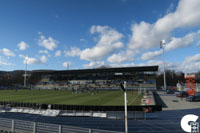
13.02.2019 © Grenzenlos Groundhopping 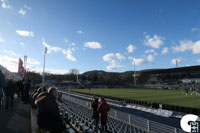
13.02.2019 © Grenzenlos Groundhopping 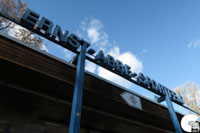
13.02.2019 © Grenzenlos Groundhopping
2011
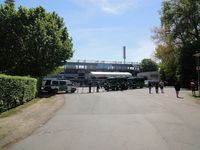
07.05.2011 © Kai, BS-MA-BS.net 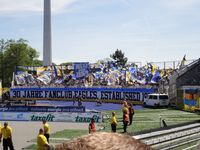
07.05.2011 © Kai, BS-MA-BS.net 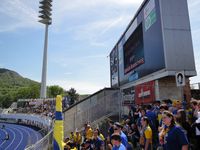
07.05.2011 © Kai, BS-MA-BS.net 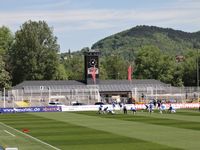
07.05.2011 © Kai, BS-MA-BS.net 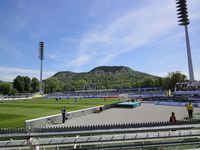
07.05.2011 © Kai, BS-MA-BS.net 
07.05.2011 © Kai, BS-MA-BS.net 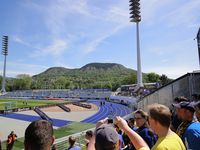
07.05.2011 © Kai, BS-MA-BS.net 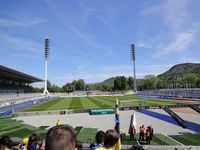
07.05.2011 © Kai, BS-MA-BS.net 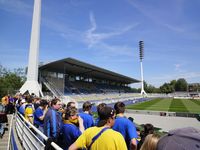
07.05.2011 © Kai, BS-MA-BS.net 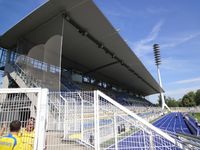
07.05.2011 © Kai, BS-MA-BS.net
2007
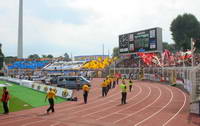
19.08.2007 © groundhopping.de 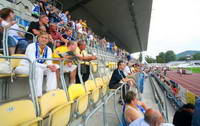
19.08.2007 © groundhopping.de 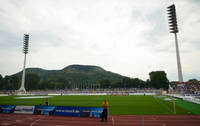
19.08.2007 © groundhopping.de 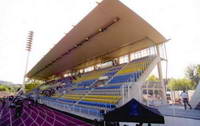
19.08.2007 © groundhopping.de
2006
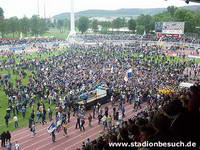
20.05.2006 © stadionbesuch.de 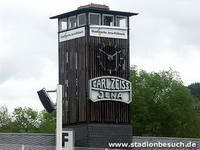
20.05.2006 © stadionbesuch.de 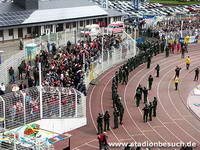
20.05.2006 © stadionbesuch.de 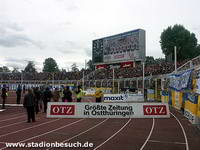
20.05.2006 © stadionbesuch.de
Related news
2024
2020
-

Germany: Jena stadium ready for groundbreaking
Simplified and optimised – the new Jena football stadium has been presented in its final iteration. Work is expected to begin within weeks. It's expected to be ready for opening exactly on June 30, 2023.
-

Germany: Pendemic or not, Jena is going forward with stadium
Just days before final deadline, authorities of Jena have signed the contract that will see new municipal stadium delivered by late 2023. Works could begin as soon as September of this year.

 StadiumDB
StadiumDB